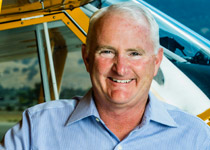Cub effect
A flight that changed my life

I typically use this space to bring you up to date on issues that affect our flying. But this month, as the ice begins to melt, I’m remembering a life-changing flight that took place quite a few years ago, just as the ice melted on Forest Lake in Minnesota.
It was my first flight in N1352C, a Piper PA–18 Super Cub that remains one of my great aviation loves.
I first met Five-Two-Charlie in the early 1990s. A friend of my dad’s had been taking care of a lake house with a hangar and an “old plane.” Neither my dad nor his pal knew what type of airplane it was, but they wondered if I’d like to take a look. And when we opened the hangar door, I wasn’t sure either. The airplane was covered in plastic and parts of it were painted blaze orange.
Then I saw the logbooks, neatly set out on the work- bench. It was a 1953 Super Cub with 309 hours total time. Last flown in the 1970s, the airplane was a time capsule just waiting to be cracked open. It was sitting on straight floats, but there were skis and wheels in the hangar as well. The fabric had been replaced in the 1960s. There was no radio and no transponder, but the original Lycoming O-290-D2 engine had been carefully pickled. And I knew I had to have it!
Enter Jerry Waldorf. He’d bought the airplane brand new in 1953 for $6,600, including the floats and skis. He was a tough negotiator, winning a $600 cash discount, according to the receipt. Decades later, he was still a tough negotiator.
Before I could make an offer on the airplane, I had to ask—why the blaze orange paint? Jerry, who had served in the infantry in the Battle of the Bulge, told me his wife had made him paint the airplane so he could be found if he ever went down. My question answered, Jerry had a few questions for me. I got the impression he was interviewing me to make sure I was worthy of his baby.
I guess I passed because we went on to talk price. I brought a copy of Trade-A-Plane as a reference, but it didn’t help. With no category for “barn finds” and an owner who clearly loved his airplane—even though he hadn’t flown it in 20-odd years—this wasn’t going to be easy. My first offer was $30,000. Jerry wanted $40,000. We wrangled for hours, and it was getting late. Desperate, I offered to split the difference at $35,000. He suggested a coin toss—$35,000 if I won and $36,000 if he did. The loudest “yippee” I’ve ever heard told me I’d lost the toss, but the airplane was mine and I couldn’t have been more excited.
The following spring, I hired a couple of mechanics to begin waking up Five-Two-Charlie. We had to cut down large trees that had grown in front of the hangar during the airplane’s long nap. Then we had to wait for the ice to melt. And at this point, I still didn’t have a seaplane rating.
At the local seaplane base, Surfside, I met owner Bruce Hanson, who has become a great friend. He remembered Five-Two-Charlie stopping in for avgas in the 1960s. And he pointed me to flight instructor Brian Schanche. Chatting after a flight, I asked Brian how long he’d been doing this. His answer—about two days. I was his very first seaplane student, and I guess I didn’t scare him off because he’s still instructing today.
Just as soon as the ice melted, Brian and I headed to the lake for our first flight in Five-Two-Charlie. It was a flight that changed my life. I had loved the airplane at first sight. But once we lifted off, I knew this was flying as it was meant to be.
For years I flew it all summer on floats, all spring and fall on wheels, and all winter on skis. With the airplane parked in my backyard on the lake, I could take off anytime I wanted. And I would gladly take anyone for a hop, even if I had just 15 or 20 minutes to spare.
I put more than 500 hours on the original 135-horsepower engine. Then in 1999, I decided it was time for an upgrade. Over the course of a year, the airplane got new fabric and some great mods, a 160-horsepower engine, and new Wipline 2100 amphibious floats.
I had a hard time waiting to get my baby back, but boy was it worth the wait.
In the years since, I’ve put more than 1,000 hours on Five-Two-Charlie. It’s taken me to Baja, California; Hudson Bay, New York; Key West, Florida; and the Idaho backcountry, to name just a few of our more exciting destinations. And it’s been a trainer for friends and family who’ve learned to fly on wheels, floats, and skis.
I’ve never regretted my love affair with Five-Two-Charlie. For me, it’s the most fun you can have in an airplane. And, while flying is never “cheap,” it is reasonable to operate, insure, and maintain.
This is an airplane I plan to keep flying as long as I can—and when I’m gone my kids will have to fight over it, to see who’s lucky enough to become just the third owner since 1953.
Email [email protected]
AOPA President Mark Baker started flying in 1979 while in college at the University of Minnesota.


